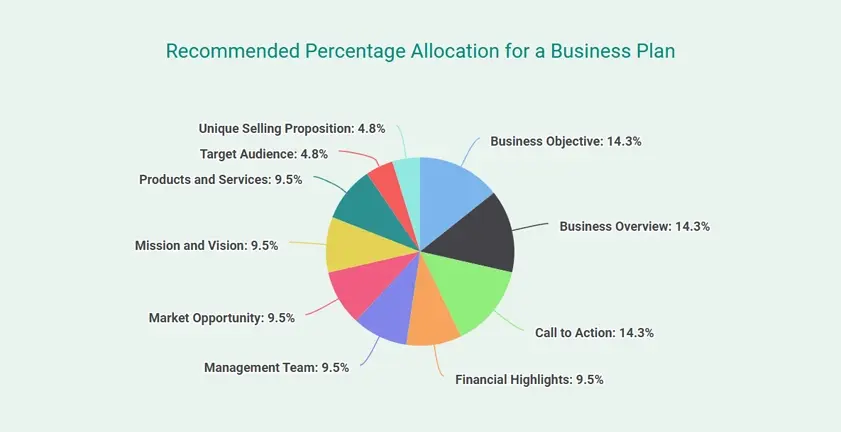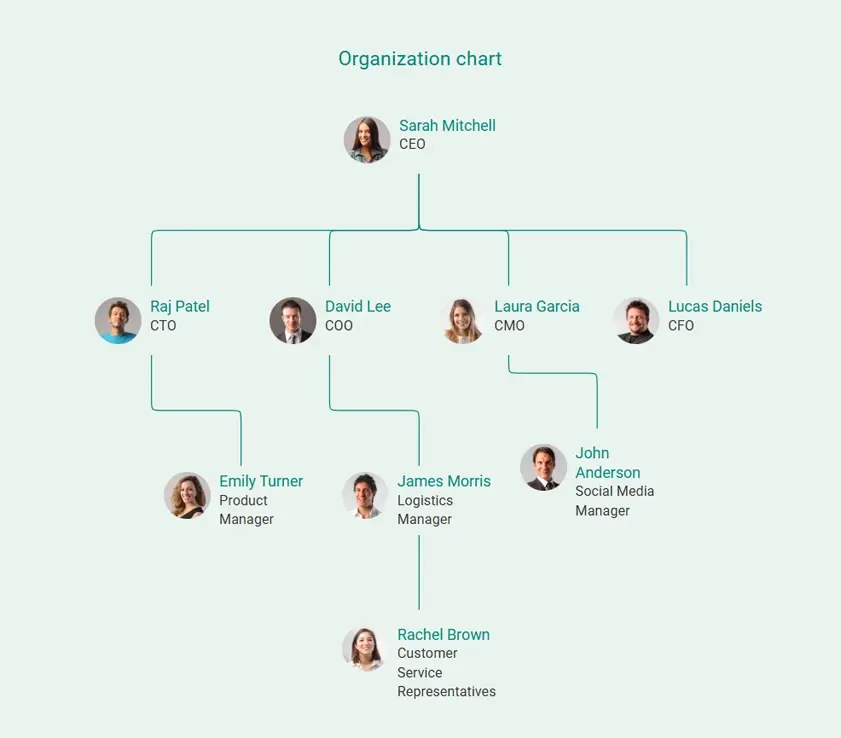We review a lot of business plans, and a common pattern stands out: The format looks fine at first glance, but the content feels either padded or vague.
It's clear someone followed a template, but didn’t stop to think, “What will actually move the needle for my business?”
That usually happens when founders try to say too much or say the wrong things. They include every section they’ve seen online, from mission statements to market trends, but skip things like strategy, numbers, and execution.
In our consulting work, the most useful plans are the ones that are focused. They get the important parts right.
So in this article, I’ll walk you through those key elements. These are the ones investors pay attention to, lenders ask about, and leadership teams actually use to make decisions. If you're building a business plan that needs to workstart here.
9 Common elements of a business plan
A strong business plan lays the foundation for any successful business, but only when it includes the correct elements.
So, here's a list of common elements of a business plan that you should consider to make your business plan effective and impactful:
1) Executive summary
Think of the executive summary as a condensed version of your entire business plan—no more than 10% of the original document. It provides a quick, clear overview, highlighting the key points and offering a snapshot of what the full plan entails.
The executive summary is crafted to capture the reader’s attention and establish a meaningful connection, compelling them to explore the rest of your business plan. Its primary purpose is to present essential business insights in a clear, concise, and impactful manner.
Here’s a quick list of reasons that make the executive summary the most important element of your business plan:
- Highlights key points and differentiates your business from others.
- Provides a snapshot of your business, giving readers a quick understanding.
- Helps investors or stakeholders quickly assess the viability of your business idea.
- Sets the tone for the rest of the business plan, creating a professional first impression.
If you're unsure about what to include and how detailed your executive summary should be, the following chart will help guide you on the ideal amount of information for maximum impact.

From experience, I can tell you this section makes or breaks the plan. I’ve had investors tell me they stopped reading because the executive summary didn’t grab them or because it didn’t answer the “why now?” question. That’s why I always treat it as the single most important page you’ll write.
Need more information or tips on how to write an executive summary for your business plan? Check out our blog on writing an executive summary for a business plan.
2) Company description
Another element that truly lays the foundation for your business plan and makes it stand out is your company description. This isn’t just a formality—it’s where you tell your story by including details like:
- What your business does
- What problem does it solve
- Why it matters
Investors want to know why your business exists, how it’s different from others, and, most importantly, why it has potential. Don’t just list your products or services—show how your company fills a gap in the market and how you plan to scale.
Here are five key reasons why the product and services element is crucial in a business plan:
- Establishes credibility and confidence in your business.
- Explains how your product can scale and capture market share.
- Explains your pricing model, helping stakeholders understand your revenue generation approach.
- Helps you demonstrate how your product directly addresses customer pain points.
- Highlights key selling points, guiding your marketing strategy and ensuring consistency in messaging.
I often challenge clients to answer one simple question here: “Why should anyone care about this business?” The best descriptions are factual as well as intentional. They reflect how well you understand the bigger picture and your place in it.
3) Market analysis
Market analysis is a powerful element in your business plan, much like a weapon in a battle. If you include it in your plan, it will show your stakeholders just how deep your understanding of the business is.
If your goal is to impress stakeholders and clearly convey the potential of your business, this element is a must-have in your business plan. Here's what you should include to make your market analysis effective:
Provide a snapshot of the industry you're entering. It should include the following:
- Market size
- Trends in business
- Future growth projections
Define your ideal customers with precision.
- Who are they?
- Where are they?
- What are their buying behaviors?
Highlight the pain points or gaps in the market that your business addresses.
- What solution does your business solve?
- Why is your solution different from the competition?
- How will it help audiences to solve their problems?
Show who your competitors are and what sets you apart
- Inform who your direct competitors are.
- Highlight what differentiates your business from your competitors.
- Explain how you plan to position your business in the market relative to competitors.
Share any relevant trends or shifts that support your business's potential.
- Include changing consumer behaviors
- Inform emerging opportunities
- Showcase technological advances
Including a thorough market analysis in your business plan demonstrates your expertise and assures stakeholders that your business has a well-researched foundation for success.
Tips to write a market analysis section in a business plan:
- Include graphs, statistics, and numbers to bring readers' attention.
- Highlight the numbers with bold fonts or using different colors.
- Back up your analysis with case studies, customer testimonials, or examples from similar businesses.
- Use concise language to break down complex concepts.
- Only include data and trends that directly impact your business.
4) Product and services
Think of the product and services section as the salt in your business plan—just as salt is vital to enhancing the flavor of food, this section is crucial to the overall impact of your plan.
Including this element allows your stakeholders to easily find answers to key questions such as:
- What is it?
- Who’s it for?
- Where’s it available?
- When should one use it?
- How to use it?
- What value proposition does it offer?
Your aim should be to target your audience with clarity and precision. Use this section to showcase how your product or service aligns with the needs of your target market and stands out in the industry.
In my reviews of business plans, I’ve noticed this section almost always swings to one extreme—it’s either too technical (full of jargon and product specs) or too vague (so light on detail that investors can’t grasp the real value). The sweet spot is explaining your product in plain language while showing exactly what gives it an edge.
I often ask founders: If I knew nothing about your industry, would I still understand what makes this worth buying? The answer is usually no.
That’s why I recommend using a simple chart or summary table. It breaks down your product, services, and unique selling points (USPs) in a way that’s skimmable and memorable, especially for investors or partners who don’t know your space inside out.

Additionally, focus on:
- Benefits, not just features: Highlight how your offering solves problems or improves your customers' lives.
- Real-world scenarios: Relate your product or service to practical, everyday use cases to make it relatable.
- Uniqueness: Emphasize what sets your product or service apart from competitors.
This section is your opportunity to describe what you're offering and convince stakeholders why it's indispensable and has the potential for long-term success.
5) Marketing and sales strategy
This section is an absolute must-have in your business plan because it showcases how you’re going to bring your product or service to market and generate revenue.
Let us break it down for you so you can craft a compelling and practical strategy.
Why does it matter?
Think of your marketing and sales strategy as the bridge between your product and the people who need it. A great product won’t move if no one knows it exists or understands why it’s valuable.
This is where a lot of founders get stuck. In my consulting sessions, I often see plans filled with vague lists of channels like “SEO,” “social,” “influencer marketing,” with no explanation of why those tactics make sense for their specific business or audience.
When this comes across my desk, my team and I dig deeper. We ask: Why these channels? Why now? How does this connect to your audience’s actual buying behavior? The answers (or lack of them) tell us whether the strategy will actually work or needs a rewrite.
What this section needs to do is show that you’ve thought it through. You’re listing tactics, showing how you plan to reach your target market, engage them in a meaningful way, and turn interest into revenue. That clarity is what gives investors and stakeholders confidence.
Key components of marketing and sales strategy:
| Component | Details | Example |
|---|---|---|
| Target Audience | Define who your customers are and their needs. | Millennials seeking sustainable products. |
| Marketing Channels | Platforms to reach your audience. | Instagram, email, trade shows. |
| Unique Tactics | Standout strategies to attract attention | Product demos, referral programs. |
| Sales Funnel | Steps from awareness to purchase. | Ads → Website demo → Discount offer. |
| Revenue Model | How you’ll generate income. | Subscriptions, one-time sales. |
| KPIs | Metrics to track success. | Conversion rates, ROI, customer acquisition. |
6) Organization and management
This is a crucial element that will spark great interest among stakeholders. By including this section, your readers will clearly understand:
- What is your business structure? (Partnership, LLP, or Sole Proprietorship)
- How many members are on your team?
- What roles do they play?
- Who holds which position?
- How will the team work together to drive the business forward?
- What experience do they bring to the table?
When stakeholders can access this detailed information, they will feel more confident about the viability of your business.
I always stress this: Even if you’re just starting out, your business plan should clearly show who’s responsible for what. When roles are unclear, investors assume execution will be too.
A simple, honest breakdown of your team structure helps build trust. It shows stakeholders that your business has real people behind it, ready to carry out the plan.
This part of the plan reassures potential investors that the risk is managed and the leadership is aligned. That’s why it’s not just a formality; it’s a signal of readiness.
One final tip: Don’t overinflate titles or stack fake layers. If it’s a three-person team, say so. Clear, grounded roles earn more trust than buzzword-heavy org charts.
To make this easier, here’s a sample management chart you can use to map out your team and responsibilities.

7) Operational plan
Consider the operational plan as the engine of your business plan. Without this crucial element, your business will struggle to move forward and fail to gain traction. It's a section where you’ll be able to showcase the real groundwork of your business.
While other sections set the vision and strategy, the operational plan answers the all-important question: "How will you actually make this happen?"
I’ve worked with startups that had amazing product ideas but no clue how they’d fulfill orders or manage logistics. That’s where strong operational planning becomes the difference between an idea that lives on paper and one that actually works in the real world.
What readers are looking for here is simple: proof that you’ve thought through the details. From location and suppliers to tech stack and cost control, this section should show that you’re building something tangible and sustainable.
To bring it to life, cover the following:
- Where will operations take place? (Office, factory, online platform)
- What tools, systems, or technologies will you use?
- What are the key roles and responsibilities of your team members?
- Who are your manufacturers, distributors, or service providers? And why did you choose them?
- How you're controlling costs and allocating resources effectively
We turn this into a flowchart. It helps founders spot weak spots like over-reliance on one vendor or missing support roles.
8) Financial plan
Investors want assurance that you have a clear plan for how much funding you need, how you intend to generate revenue, and how you will sustain profitability over time.
Without a solid financial plan, you're essentially asking them to take a leap of faith. And, to be honest, no seasoned investor does that without a clear financial map.
I’ve seen founders pitch brilliant ideas with vague numbers, unrealistic projections, or no clear funding use. It’s an instant red flag. In my experience, numbers should speak as clearly as your words, if not more so.
That’s why I tell every founder I work with: Your financial plan isn’t just about spreadsheets. It’s about showing you understand the economics of your business and can make smart, data-backed decisions.
A financial plan is an essential element of your business plan because it helps you attract the right investors and foster confidence among your stakeholders. Here are a few tips to make your financial plan more effective:
- Be crystal clear on how your business will make money. Will you sell products, offer subscriptions, charge for services, or have a combination of these?
- Detail your initial funding requirements. How much do you need to get your business off the ground, and where will this money come from?
- Showcase your income, cash flow, and balance sheet statement for better clarity.
- Inform when your business will start generating profits.
- Mention whether you're seeking venture capital, a bank loan, or angel investors; you need to explain how you'll use the funds and your plan for repayment or equity-sharing.
- Explain how you'll address potential risks and strategies for handling them.
When we build business plans for clients, we don’t just plug in numbers; we make sure the story behind those numbers is airtight. The more robust and realistic your financial plan, the more likely you are to attract the right investment and the trust of serious stakeholders.
9) Appendix
The appendix might seem like an afterthought in your business plan, but it's a crucial element that can make all the difference.
This section is your chance to share important details. The appendix exists for exactly that reason; it’s where you park supporting documents, data, and references that add depth without breaking the flow of your core message.
And because it’s a natural place to store proof, it’s also the first place I look when reviewing funding-focused plans. It’s the quickest way to see if someone’s serious—real numbers, contracts, legal documents—versus fluff.
In my own reviews, I can often tell within minutes if a founder has done their homework just by scanning what’s in the appendix. That’s why I tell clients to treat it as their credibility file, the place that proves every projection, claim, and milestone in the plan has real evidence behind it.
If an investor wants to dig deeper, this is the section that convinces them you’re not just telling a good story; you can back it up.
Take a quick look at what you can add in your appendix:
| Appendix Element | How it elevates your business plan |
|---|---|
| Resumes of Key Team Members | Demonstrates the experience and expertise driving your business. |
| Market Research | Validates your market assumptions and shows you've done your homework. |
| Detailed Financial Statements | Provides transparency and supports your financial projections and funding needs. |
| Product Photos/Prototypes | Gives a visual representation of your product, helping stakeholders envision it. |
| Legal Documents | Proves that your business is legally sound, with necessary licenses or patents. |
| Customer Testimonials/Feedback | Shows proof of concept and market interest, increasing trust in your idea. |
| Contracts or Agreements | Highlights key partnerships or customer commitments that support your business model. |
For more details, check out our dedicated business plan appendix blog.
Conclusion
A well-structured business plan is the cornerstone of a successful business. When it includes the correct elements, as discussed in this blog, it can work wonders for your organization.
Including the correct elements in a business plan takes experience and expertise. Even a small mistake can undermine the entire plan. That’s why seeking help from platforms like Plangrowlab can make all the difference.
On this platform, you can easily hire expert business plan consultants who will guide you in crafting a well-structured business plan and ensure you include the right elements with accuracy and precision.
So why wait? Consult today!
Frequently Asked Questions
What are the essential elements of a business plan?
Key elements include the executive summary, company description, market analysis, products and services, marketing and sales strategy, operational plan, financial plan, and appendix.
Why is the executive summary so important in a business plan?
An executive summary provides a concise overview of your business, grabs attention, and encourages the reader to explore the rest of the plan.
How detailed should the market analysis section be?
It should provide clear insights into the industry, target market, customer demographics, competitors, and market trends, backed by data.
What financial statements should be included in a business plan?
Include an income statement, cash flow statement, balance sheet, and break-even analysis to provide a clear financial picture.
Do I need to include an appendix in my business plan?
Yes, it’s important for supporting documents like team resumes, market research, legal documents, and detailed financials, without cluttering the main plan.


